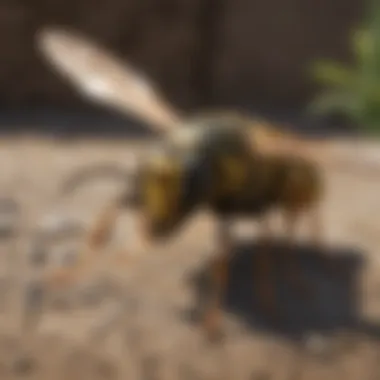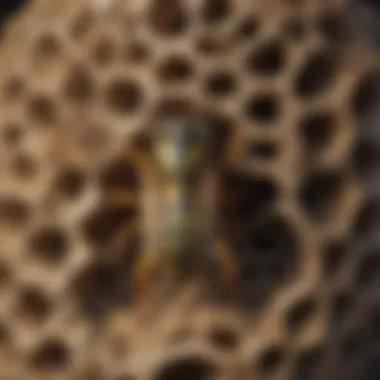Comprehensive Guide to Effective Wasp Infestation Treatment Methods


Preventive Pest Control Strategies
House Exterior Protection
When it comes to preventing pesky wasp infestations, ensuring your house's exterior is well-protected is paramount. Sealing cracks and crevices with caulk and weatherstripping can be a game-changer. Additionally, clearing debris such as fallen leaves and wood can eliminate potential nesting spots for wasps. Another crucial tip is to safeguard entry points like gaps around windows and doors to prevent these stinging insects from sneaking indoors.
Yard Maintenance
Maintaining a well-kept yard is essential in warding off wasps. Regularly mowing the lawn, trimming bushes and trees, and removing standing water can help keep these insects at bay. Implementing pest-resistant plants and flowers can also discourage wasps from making a home in your outdoor space.
Indoor Cleanliness
Indoor cleanliness is key to deterring wasps from setting up shop inside your home. Adopt expert cleaning techniques to ensure no food residues are left behind, as this can attract various pests, including wasps. Keeping a clutter-free environment and promptly fixing any plumbing leaks can greatly reduce the likelihood of a wasp infestation.
Garbage Disposal
The way you dispose of your household waste can significantly impact your risk of a wasp invasion. Opt for efficient waste disposal methods like using sealed bins and ensuring trash bags are tightly closed. Proper garbage disposal not only keeps your surroundings clean but also minimizes the chances of attracting unwanted insect visitors.
Other Pest Prevention Strategies
In addition to the aforementioned tips, various innovative strategies can further fortify your home against pests. From using natural repellents like peppermint oil to installing mesh screens on windows, exploring diverse prevention methods can enhance your pest management efforts.
Understanding Wasp Behavior


Understanding the behavior of wasps is of paramount importance when addressing wasp infestations. This section sheds light on the intricacies of wasp behavior, essential for effective treatment strategies. By delving deep into how wasps operate, individuals can better grasp their habits, triggers, and patterns, aiding in devising meticulous control measures to combat infestations. Recognizing the distinct behaviors of wasps equips homeowners with the knowledge to protect their households and environments from these stinging insects.
Ecosystem Role
Wasps play a crucial role in the ecosystem, primarily as predators of other pests. They prey on insects that can harm crops and plants, thus contributing to natural pest control. Understanding this vital ecological function of wasps underscores the need for a balanced approach to wasp infestations. By appreciating their ecological significance, individuals can explore humane ways to manage wasp populations without disrupting the ecosystem's delicate harmony.
Nesting Habits
Exploring the nesting habits of wasps illuminates their nesting preferences, materials used, and locations favored for constructing nests. By understanding these nesting habits, individuals can identify potential nesting sites around their homes and take proactive measures to deter nest-building activities. Recognizing the distinctive traits of wasp nests aids in timely intervention, preventing infestations before they escalate.
Aggression Triggers
An awareness of the factors that provoke wasp aggression is crucial for personal safety and effective treatment. This section examines the triggers that incite defensive behavior in wasps, such as proximity to nests, sudden movements, or loud vibrations. By comprehending these triggers, individuals can avoid provoking wasps and reduce the risk of stings. Awareness of aggression triggers enhances safety measures and promotes a harmonious coexistence with these beneficial yet formidable insects.
Preventive Measures
In the realm of effective treatment for wasp infestations, the role of preventive measures cannot be overstated. By implementing a proactive approach to addressing wasp problems, homeowners can significantly reduce the risk of infestations taking root on their property. Preventive measures serve as the first line of defense against these stinging insects, ultimately avoiding the need for more drastic control methods. One key aspect of preventive measures is sealing entry points, which involves meticulously inspecting the property for any openings or gaps through which wasps can enter. By identifying and promptly sealing these entryways, individuals can fortify their home against potential incursions by these pesky insects. Additionally, removing attractants is crucial in deterring wasps from congregating around the property. This may involve minimizing the presence of sweet substances or flowers that attract these insects, thereby creating a less appealing environment for them. Moreover, landscaping tips play a vital role in preventing wasp infestations. Strategic landscaping choices, such as planting certain insect-repelling plants or placing decoy nests, can help deter wasps from nesting in the vicinity. Overall, preventive measures form an integral part of a comprehensive strategy to combat and manage wasp infestations effectively.
Sealing Entry Points
Sealing entry points is a fundamental aspect of wasp control that can significantly reduce the likelihood of infestations. The process involves a meticulous examination of the exterior of the property to identify potential entry points for wasps. Common areas of concern include gaps in window frames, cracks in walls, or openings around utility entrances. These entry points serve as gateways for wasps to infiltrate the premises and build nests. Once identified, it is essential to promptly seal these openings using appropriate materials such as caulk or sealant. By effectively sealing entry points, homeowners create a barrier that limits the access of wasps to the interior of the property, thereby minimizing the chances of infestations taking hold. Regular inspections and maintenance are key to ensuring that new entry points do not emerge, maintaining the integrity of the protective seal established.
Removing Attractants


The presence of attractants can lure wasps to a property and increase the risk of infestations. To mitigate this risk, homeowners should take proactive steps to remove attractants that draw in these stinging insects. Common attractants include unsealed garbage bins, fallen fruits, sugary drinks, and outdoor pet food. By diligently addressing these attractants and implementing proper waste disposal practices, individuals can significantly reduce the attractiveness of their property to wasps. Maintaining a clean and tidy outdoor environment is crucial in this regard, as it minimizes opportunities for wasps to forage for food or building materials in the vicinity. By removing attractants, homeowners create a less hospitable environment for wasps, discouraging them from establishing nests in the surroundings.
Landscaping Tips
Strategic landscaping can serve as a powerful tool in warding off wasp infestations and maintaining a wasp-free environment. When planning landscaping around the property, homeowners can choose plants that naturally repel insects, such as mint, marigolds, and basil. These plants emit scents that deter wasps and other pests, acting as a natural barrier against infestations. Additionally, incorporating decoy nests or structures that mimic wasp nests can trick incoming wasps into believing the territory is already occupied, deterring them from building nests in the area. Landscaping tips also include maintaining vegetation away from the house, trimming bushes and trees regularly, and disposing of yard waste promptly. By thoughtfully designing the landscape and implementing preventive measures, homeowners can create an environment that is unwelcoming to wasps, reducing the likelihood of infestations and ensuring a harmonious living space.
DIY Wasp Control Methods
In the realm of wasp infestations, understanding the significance of DIY control methods is paramount. Not only do these methods empower individuals to take charge of their living spaces, but they also allow for a proactive approach in dealing with potential issues before they escalate. DIY strategies serve as a cost-effective and immediate response to the presence of wasps, granting homeowners a sense of autonomy in safeguarding their properties. By exploring natural repellents, traps and baits, as well as safe nest removal techniques, individuals can effectively mitigate the risks associated with wasp infestations.
Natural Repellents
When addressing wasp infestations, natural repellents emerge as a prudent and environmentally-conscious approach. These repellents, often derived from botanical sources, offer a non-toxic alternative to traditional chemical-based solutions. Ingredients such as peppermint oil, citronella, and even soapy water can serve as effective deterrents against wasps, discouraging them from establishing nests in close proximity to residential areas. By strategically deploying natural repellents, homeowners can create a hostile environment for wasps without endangering other beneficial insects or the ecosystem at large.
Traps and Baits
In the quest for effective wasp control, traps and baits play a pivotal role in capturing and eliminating these stinging insects. Utilizing bait stations containing sweet substances like fruit juice or sugar water can attract wasps, leading them to a trap where they are subsequently contained. Traps, on the other hand, can help reduce the population of foraging wasps in outdoor spaces, minimizing the likelihood of encounters with humans. When strategically placed around the perimeter of a property, traps and baits can act as strategic tools in managing wasp infestations without resorting to harmful chemicals.
Safe Nest Removal
Amidst a wasp infestation, the presence of nests can pose a significant threat to residents. Safe nest removal techniques are essential in ensuring the successful eradication of wasps while prioritizing safety. Identifying the type of wasps and their nesting habits is crucial in determining the most appropriate removal method. From using protective gear to conducting removal procedures during nighttime when wasps are less active, safe nest removal protocols aim to minimize the risks of stings and potential confrontations. By adhering to best practices in nest removal, individuals can effectively address wasp infestations while safeguarding their well-being and property.
Professional Extermination Services


In the realm of wasp infestation management, the utilization of Professional Extermination Services emerges as a paramount aspect essential for comprehensive treatment. Experts proficient in wasp control bring a multitude of benefits to the table, ensuring effective eradication of these buzzing pests from residential spaces. Their extensive knowledge and experience allow for a strategic approach tailored to the specific infestation, guaranteeing a successful outcome. Moreover, professional exterminators utilize advanced techniques and equipment not readily available to the general public, enhancing the efficiency and thoroughness of the treatment process. By entrusting the task to skilled professionals, individuals can rest assured that the wasp infestation will be addressed with precision and proficiency.
Benefits of Hiring Experts
The decision to engage professional extermination services for wasp infestations offers a range of compelling advantages. Firstly, these experts possess specialized training and expertise in handling various types of wasps, enabling them to accurately identify the species involved in the infestation. This knowledge is crucial in determining the most effective treatment approach, ensuring targeted and efficient eradication. Additionally, professional exterminators carry out comprehensive assessments of the infested areas, locating nests and identifying potential entry points for wasps. This thorough analysis allows for a tailored treatment plan that addresses the root cause of the infestation, leading to long-term control and prevention of wasp recurrence.
Treatment Techniques
Professional extermination services employ a diverse array of cutting-edge treatment techniques to effectively combat wasp infestations. One common method is the application of potent insecticides that target and eliminate wasp populations at the source. Exterminators may also utilize dust formulations or foams to directly treat wasp nests, ensuring complete eradication. For aerial nests or hard-to-reach locations, experts may employ specialized equipment such as long-reaching sprayers or aerosol dispensers to access and treat the infested areas. Additionally, some exterminators employ eco-friendly approaches like biological controls or natural deterrents, providing environmentally conscious solutions for wasp management.
Cost Considerations
When considering professional extermination services for wasp infestations, cost is a crucial factor that warrants attention. The pricing structure for such services may vary depending on factors like the extent of the infestation, the type of treatment required, and the size of the property. Generally, the cost of hiring experts for wasp control is influenced by the complexity of the job, with more severe infestations necessitating additional time and resources for complete eradication. While professional services may entail a higher initial investment compared to DIY methods, the expertise, efficiency, and long-term effectiveness they offer justify the financial outlay as a worthwhile investment in ensuring a wasp-free environment.
Safety Precautions
In addressing the issue of wasp infestations, prioritizing safety precautions is paramount. This section emphasizes the vital role that safety measures play in effectively managing and eradicating these stinging pests. By implementing the recommended safety protocols, individuals can safeguard themselves and their property from potential harm. Understanding the significance of safety precautions ensures a smooth and secure approach to dealing with wasps.
It is essential to wear appropriate protective gear when handling wasp infestations. This includes donning thick clothing, gloves, and closed-toe shoes to minimize the risk of stings. Protective gear acts as a barrier between individuals and the aggressive wasps, offering a layer of defense against potential attacks. Additionally, wearing light-colored clothing can help deter wasps as they are less attracted to bright colors.
Protective Gear
When it comes to dealing with wasp infestations, the use of protective gear is non-negotiable. Protective gear serves as a shield against possible stings, offering much-needed protection during removal or extermination processes. Thick, long-sleeved clothing, sturdy gloves, and closed shoes are essential components of protective gear. These items create a physical barrier between individuals and the wasps, reducing the risk of painful encounters. Prioritizing the proper attire can greatly mitigate the potential dangers associated with handling wasps.
First Aid for Stings
In the unfortunate event of a wasp sting, knowing how to administer first aid is crucial. This subsection focuses on providing detailed instructions on how to treat a wasp sting promptly and effectively. From cleaning the affected area with soap and water to applying a cold compress to reduce swelling, employing the correct first aid measures can alleviate discomfort and prevent further complications. Understanding the proper first aid techniques for wasp stings equips individuals with the knowledge to respond promptly in case of an incident.
Avoiding Provocation
To minimize the risk of provoking wasps and inciting aggressive behavior, certain precautions must be taken. This section explores strategies for avoiding actions that could trigger defensive responses from wasp colonies. Simple measures such as refraining from swatting at wasps, remaining calm and still in their presence, and avoiding strong scents or fragrances can help prevent unnecessary confrontations. By understanding how to behave around wasps and minimizing potential provocations, individuals can reduce the likelihood of being stung and promote a harmonious coexistence with these insects.



